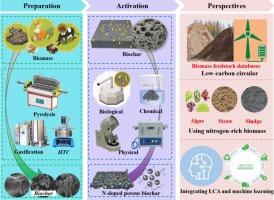将生物质固体废物升级为增值掺氮生物炭以增强对VOCs的吸附
IF 9
1区 工程技术
Q1 ENGINEERING, CHEMICAL
引用次数: 0
摘要
从生物质固体废弃物中提取的掺氮生物炭具有高选择性和高吸附效率,在控制挥发性有机化合物(VOCs)方面具有显著的潜力。本文综述了氮掺杂生物炭的热解、气化和水热炭化制备方法,并介绍了各种物理和化学活化方法。掺氮后,生物炭的含氮量提高了10.7倍,对VOCs的吸附能力相应提高了10.5倍。本文还对掺n生物炭处理VOCs的机理进行了详细讨论。氢键、静电相互作用、范德华力和π堆积被认为是主要的吸附机理。此外,还揭示了原料类型和氮掺杂方式对氮掺杂生物炭性能的影响。生物炭的氮官能团、总孔体积和比表面积是影响吸附的最关键因素。值得注意的是,原位氮掺杂工艺简单,结构氮含量高,而非原位氮掺杂具有可控的氮含量和更大的灵活性。未来,机器学习与生命周期评估的结合可以指导经济高效、高性能、可扩展的n掺杂分层多孔生物炭材料的开发。这一综述有助于后续相关研究将生物质固体废物升级为n掺杂生物炭吸附VOCs。本文章由计算机程序翻译,如有差异,请以英文原文为准。

Upcycling biomass solid wastes into value-added N-doped biochar for enhanced VOCs adsorption
Nitrogen (N)-doped biochar derived from biomass solid wastes exhibits remarkable potential for volatile organic compounds (VOCs) control due to its high selectivity and high adsorption efficiency. In this paper, the preparation methods of N-doped biochar through pyrolysis, gasification, and hydrothermal carbonization are comprehensively reviewed, and various physical and chemical activation methods are also introduced. After nitrogen doping, the nitrogen content of the biochar increased by up to 10.7 times, and its adsorption capacity for VOCs was enhanced correspondingly by up to 10.5 times. This review also provides a detailed discussion on the mechanism for VOCs by N-doped biochar. Hydrogen bonding, electrostatic interactions, van der Waals forces, and π-stacking are considered to be the main adsorption mechanisms. Moreover, the influences of feedstock types and nitrogen doping methods on the properties of resulting N-doped biochars are revealed. The nitrogen functional groups, total pore volume, and specific surface area of biochar are the most critical factors affecting adsorption. Notably, in-situ nitrogen doping offers a simple process with high structural nitrogen content, whereas ex-situ doping provides controllable nitrogen content and greater flexibility. In the future, the integration of machine learning with life cycle assessment can guide the development of cost-effective, high-performance, and scalable N-doped hierarchical porous biochar materials. This review benefits subsequent related research in upcycling biomass solid wastes into N-doped biochar for VOCs adsorption.
求助全文
通过发布文献求助,成功后即可免费获取论文全文。
去求助
来源期刊

Separation and Purification Technology
工程技术-工程:化工
CiteScore
14.00
自引率
12.80%
发文量
2347
审稿时长
43 days
期刊介绍:
Separation and Purification Technology is a premier journal committed to sharing innovative methods for separation and purification in chemical and environmental engineering, encompassing both homogeneous solutions and heterogeneous mixtures. Our scope includes the separation and/or purification of liquids, vapors, and gases, as well as carbon capture and separation techniques. However, it's important to note that methods solely intended for analytical purposes are not within the scope of the journal. Additionally, disciplines such as soil science, polymer science, and metallurgy fall outside the purview of Separation and Purification Technology. Join us in advancing the field of separation and purification methods for sustainable solutions in chemical and environmental engineering.
 求助内容:
求助内容: 应助结果提醒方式:
应助结果提醒方式:


